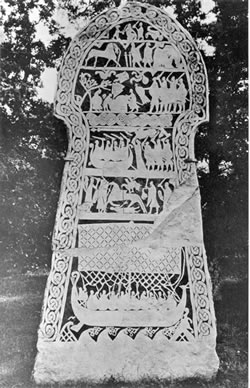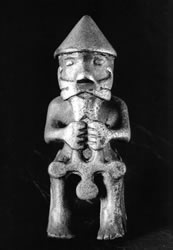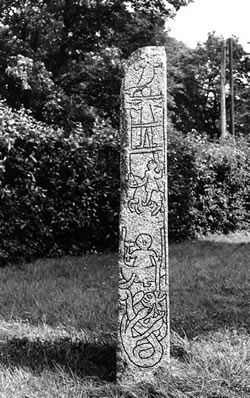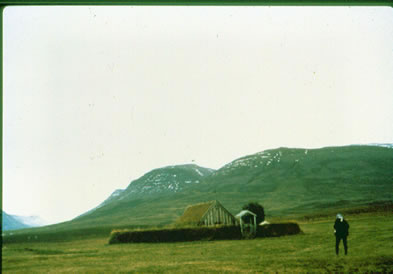Religion
Statuette of Frey, Small bronze statuette depicting the god Frey. Frey is wearing a typical conical Viking helmet., ATA, Statens Historika Museum, Stockholm
During the Viking Age Scandinavians changed from a pagan religion with many gods to Christianity, with only one God. Norse pagan religion had two groups of deities, the Vanir [singular Vanr]), associated with fertility and abundance, and Ăsir [singular ┴ss], associated with power and war. The Vanir represented ancient beliefs, the Ăsir a faith that had developed later but which had never completely replaced the Vanir. Frey and Freya were the chief deities among the Vanir. Frey was the god of fertility in both humans and crops, and his worship had long traditions. Freya was his female counterpart, and her worship may have its origin in a much older concept of a mother goddess.
Odin and Thor were the most prominent among the Ăsir. The worship of Thor was particularly popular in Iceland. Thor was the god of thunder, tempests, war and fertility. Odin, Thor’s father and the god of war and wisdom, was associated with sei, magic and sorcery. Odin became especially popular with the upper classes in Denmark and the G÷taland area in southern Sweden.
There were many other gods and contact with the supernatural world was maintained via chants, dancing and seidr. In one version, described in the Vinland sagas, Gudrid becomes an unwilling but effective participant in a seidr ceremony.
Little is known about the actual worship. Norse political leaders claimed descent from the gods and as such, they were also the religious leaders. Ceremonies were tied to banquets at the estates of the chieftains. Guests were served ample amounts of mead, beer, and wine. The drunkenness that resulted was a significant part of the cult.
During the Viking Age, Scandinavians came into direct contact with Christianity. Christian missionaries were sent from Germany and England in the late 8th and early 9th centuries to Scandinavian trading centres where many foreign traders were present.
Denmark was Christianized in the 10th century. In the late 10th century, King Olaf Tryggvason gave his vassals the choice of Christianity or death. Olaf also christianized Shetland, Orkney, and the Faeroes, and he was instrumental in the conversion of Iceland. According to Erik the Red’s Saga, he commissioned Leif Eriksson to christianize Greenland. Christianity developed in Sweden but the process took longer, and was not completed until the 12th century.
Icelanders adopted Christianity as their religion by a vote at the Althing in 999 or 1000. The decision shows that most were already familiar with Christianity, and by then many had accepted the new religion. Some, like Helgi the Skinny, practised both religions; Egil Skallagrimsson had himself Ĺprimsigned’ in England so that he could carry on deals with English merchants. Primsigning was a form of tentative baptism.
The Christianity practised was Roman Catholicism. In the early to mid-16th century all the Scandinavian countries became Lutheran Protestants, a concept that better fitted their traditional ideas of the king as head of the church.
In the pagan period the dead were placed in mounds or beneath cairns of rock located at the edge of their properties. There could be either cremations or inhumations. With the change to Christianity burial in consecrated ground became a necessity for a happy afterlife. This is reflected in the Vinland sagas where a whole expedition sets out to bring Thorvald Eriksson’s body back to Greenland. When immediate burial in a cemetery was impossible, for instance in Greenland when the ground was frozen, the bodies were stored until they could be brought to the cemetery. The Tˇsta saga tells of Corpse-Lodin whose job it was to see that the dead who had died far away from home made it to the cemetery.




Chapters in Books
- Adam of Bremen, [Religion in] Chapters 26-27, Beskrivelse af °erne i Nordern [Description of the Islands in the North], 1978
- Bernard Scudder, trans., [Religion in] Egil's Saga, The Sagas of Icelanders: A Selection, preface by Jane Smiley, introduction by Robert Kellogg, 2000
Internet Source


![[ Statuette of Frey ] [ Statuette of Frey ]](../../images/site/164310_2.jpg)